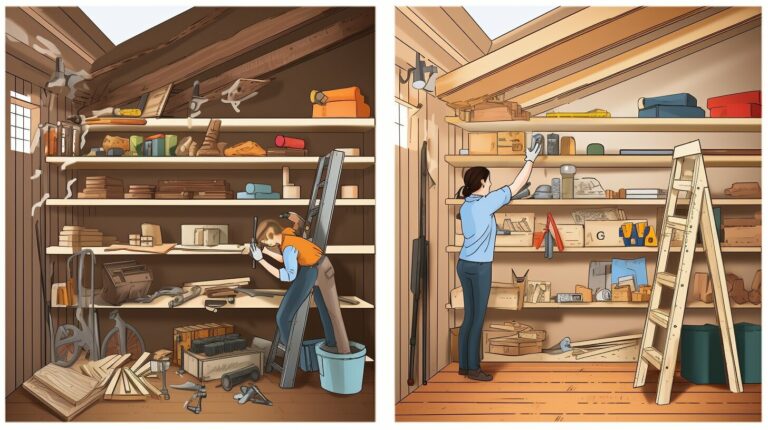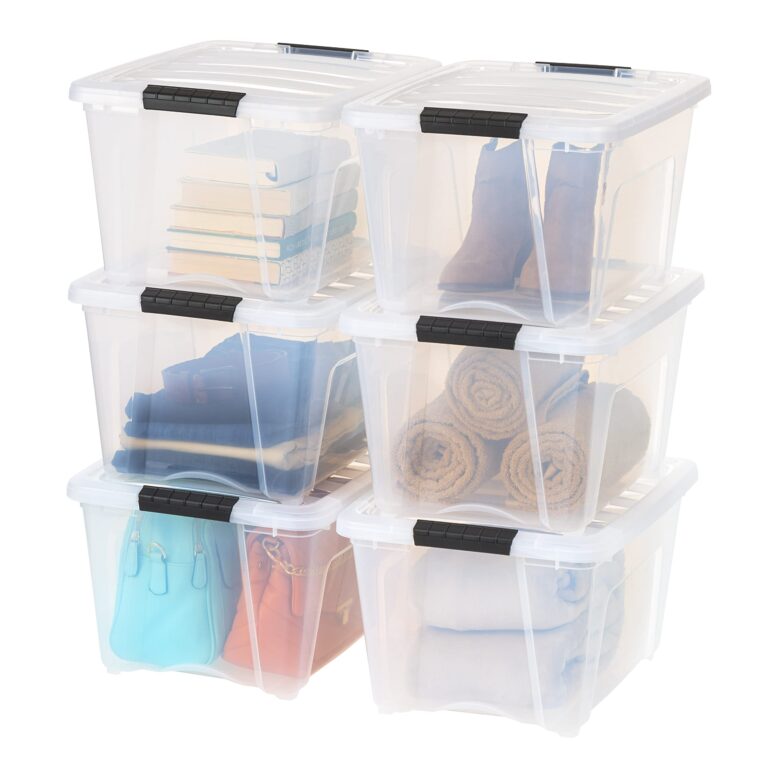Is your basement cluttered with boxes, old furniture, and unused items? Does the thought of decluttering overwhelm you? Don’t worry, we’ve got you covered. In this section, we’ll take you through a step-by-step guide on how to declutter your basement and turn it into a functional and organized space.
By following these instructions, you’ll be able to declutter your basement efficiently, leaving you with plenty of space to store and access the items you need. Decluttering may seem like a daunting task, but with our easy-to-follow instructions, it’ll be a breeze.
Key Takeaways
- Decluttering your basement is a manageable task if you approach it step by step.
- Assess your clutter before you begin decluttering.
- Create a plan and set realistic goals before you start the decluttering process.
- Sort your items and categorize them into different groups.
- Let go of the items you no longer need or use.
Assess the Clutter
Before you start decluttering your basement, it’s essential to assess the clutter to determine the scope of the project. Take a deep breath and survey the space, make a mental note of items that need to be removed, and be prepared for anything. You’ll likely find a range of items, from seasonal decorations to old electronics and broken appliances.
The key to a successful decluttering project is to categorize items into groups. Create piles for items you want to keep, donate, sell, and dispose of. As you work through the basement, make sure to label each pile. It will make it easier to keep track of what you’re keeping and what you’re letting go of throughout the process.
Remember, decluttering your basement isn’t just about clearing out space. It’s also about creating a functional and organized area that you can use. Take the time to assess what you need and what you don’t need, and you’ll be on your way to a well-organized basement.
Create a Plan and Set Goals
Now that you’ve assessed your clutter, it’s time to create a decluttering plan and set goals. This step is essential to stay focused and motivated throughout the process of organizing your basement.
Start by determining how much time you can allocate each day or week to decluttering. Be realistic with yourself and consider your other commitments and responsibilities. Setting achievable goals for each session will also help you stay on track and avoid feeling overwhelmed.
As you create your plan, think about the end result you want to achieve. Visualize your basement as a well-organized and functional space, and use that vision as motivation to keep going.
Consider breaking down your plan into smaller tasks or sections, such as tackling one area of the basement at a time. Having a plan with specific steps will help you stay focused and give you a sense of accomplishment as you complete each task.
Remember to be flexible with your plan as well. If you find that one method isn’t working, don’t be afraid to adjust and try something new.
By creating a decluttering plan and setting goals, you’ll be well on your way to achieving a clutter-free and organized basement.
Sort and Categorize
Now that you’ve assessed the clutter in your basement, it’s time to sort and categorize the items. This step is crucial in making sure that the items are organized and easily accessible once the decluttering process is complete.
Create designated areas for each category of items such as holiday decorations, tools, sports equipment, and so on. Place similar items in the same boxes or containers. This will help you avoid confusion and make it easier to find things when you need them.
When sorting items, be sure to include anything that is broken or damaged. Make a separate pile for items that you can repair and dispose of the ones that are beyond repair. For items that you no longer need or use, consider selling or donating them to someone who might find them useful.
| Category | Description |
|---|---|
| Holiday decorations | Christmas ornaments, Easter baskets, etc. |
| Tools | Power tools, hand tools, etc. |
| Sports equipment | Bikes, balls, helmets, etc. |
Sorting and categorizing your items will make it easy to organize and store them in the next step. It will also help you identify any patterns in the clutter and take measures to prevent future clutter from accumulating.
Purge and Let Go
Now comes the hard part: purging and letting go of the items you no longer need or use. This can be an emotional process, but remember that the goal is to create a functional and clutter-free basement.
Start by going through each category of items and asking yourself if you really need them. Be honest with yourself and consider if each item brings value to your life or if it’s just taking up valuable space. If the item is broken or unusable, dispose of it. If it’s still in good condition, consider donating or selling it.
It’s important to be ruthless during this process and to not hold onto items out of guilt or obligation. Keep only what you need and what brings you joy.
Once you’ve purged all unnecessary items, you’ll be left with a clearer and more functional basement space. Don’t be afraid to ask for help from family or friends during this process, as an outside perspective can be helpful in deciding what to keep and what to let go.
Remember, the goal is to simplify your life and your space. By purging and letting go of excess items, you’ll create a peaceful and organized environment in your basement.
Organize and Store
Now that you’ve purged and let go of items you no longer need or use, it’s time to organize and store the remaining items in your basement. Investing in storage solutions such as shelves, bins, and hooks can help you make the most out of your space. Here are some tips to help you organize your basement:
- Create designated areas for different categories of items. Label shelves or containers for easy access and maintenance of the system that suits you best.
- Store seasonal items that aren’t frequently used, such as holiday decorations or lawn equipment, in a separate area.
- Consider the types of items that need to be stored on shelves versus those that can hang on hooks. This will prevent overcrowding and make items more accessible.
- If your basement has limited lighting, place items you use frequently in well-lit areas or use adhesive lighting strips to improve visibility.
- Finally, avoid stacking items too high on shelves, as this can make it difficult to access them. Instead, opt for shorter stacks or invest in sturdy step stools to reach higher items.
By following these tips and investing in appropriate storage solutions, you can create a well-organized and highly functional basement that is easy to navigate and maintain.
Maintain and Prevent Future Clutter
Congratulations, you’ve successfully decluttered your basement! However, to ensure it stays clutter-free, you’ll need to establish some habits and routines to maintain the organized space. Here are some tips:
- Maintain a Regular Cleaning Schedule: Plan to clean and organize your basement at least once a month. This could include dusting shelves, wiping down surfaces, and reorganizing any items that may have strayed from their designated areas.
- Implement a “One In, One Out” Rule: For every new item you bring into your basement, make sure you remove an old one. This will prevent clutter from accumulating and help you maintain a well-organized space.
- Label and Reassess Your Storage Solutions: As you start using your newly organized space, you may find that certain storage solutions aren’t working as well as you’d hoped. Take the time to reassess and adjust as necessary. Make sure to label boxes and containers so you know exactly where everything is located.
- Donate or Sell Unneeded Items Regularly: Prevent future clutter by regularly going through your basement and identifying items that you no longer need or use. Consider donating or selling these items instead of letting them take up valuable space in your basement.
By implementing these habits and routines, you’ll be able to maintain an organized basement and prevent future clutter from accumulating. Remember, consistency is key!
Conclusion
Decluttering your basement can be a challenging task, but following these easy-to-follow steps can make the process less overwhelming. By starting with assessing the clutter and creating a plan, you’ll be able to prioritize your belongings and stay focused on your goals. Sorting and categorizing your items, purging those you no longer need, and organizing and storing the remaining items will create a more functional space in your basement.
Don’t forget to maintain your newly decluttered basement by regularly cleaning and organizing the space. Implementing habits and routines, such as the “one in, one out” rule, can help prevent future clutter from accumulating. With a little effort and consistency, your basement can become a clutter-free haven that you’ll love spending time in.
FAQ
Q: How do I assess the clutter in my basement?
A: Take a thorough look at the items in your basement and categorize them into different groups, such as keep, donate, sell, and dispose of. This will help you prioritize and plan your decluttering strategy.
Q: How do I create a decluttering plan and set goals?
A: Determine how much time you can allocate to decluttering each day or week and set realistic goals for each session. Having a plan in place will keep you focused and motivated throughout the process.
Q: How do I sort and categorize the items in my basement?
A: Create designated areas for different categories, such as holiday decorations, tools, or sports equipment. This will make it easier to find and store items once the decluttering process is complete.
Q: How do I decide what items to purge and let go of?
A: Be ruthless and ask yourself if each item brings you joy or serves a practical purpose. Consider selling or donating items in good condition and dispose of items that are no longer usable.
Q: How do I organize and store the remaining items in my basement?
A: Invest in storage solutions such as shelves, bins, and hooks to maximize space. Label boxes or containers for easy access and maintain an organized system that suits your needs.
Q: How do I maintain my decluttered basement and prevent future clutter?
A: Regularly clean and organize the space to ensure everything stays in its place. Establish habits and routines that keep clutter at bay, such as implementing a “one in, one out” rule for new items entering the basement.


